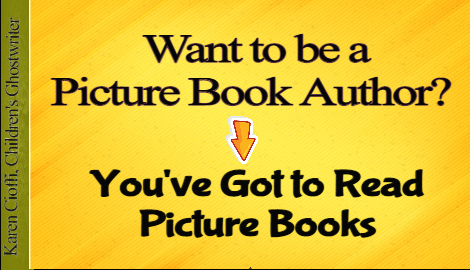If you want to be an author of a picture book, you need to read picture books. That's just the way it is. I’ve written about this in the past, but I’m still getting outlines and drafts with an adult as the main character in the stories. In fact, in the two most recent there were NO children in the story and they were to be children’s picture books. One of the basic guidelines for writing for children is that the story must revolve around a child. While this is the guideline and that’s that, it’s really about the young reader. Kids want to read books about kids, not adults. The age group of the intended reader will determine the age of the main character (MC). As children like to read up, the MC should be a little older than the intended reader, or at the very least, the MC’s age should be at the top of that targeted age group. With all the information online, if you’re thinking of writing a children’s book or you started one, hopefully you’ve done some research and you should know this basic information. So, why does this still happen? Why do I still get stories from clients with adults as the main character? It’s simple: The author hasn’t bothered reading current children’s books or researched in the genre you want to write. I recently attended a Highlights workshop on picture book structure with Leslie Helakoski and Darcy Pattison. Every year or every other year, they both read 100 books published within the last five years. And they get those books from the library. Why is getting the books from the library essential? It’s essential because if a book has made it into the library, it’s a quality book, whether traditionally published or self-published. This is not to say that self-published books that don’t make it into the library system are of poor quality, it’s just that those already in the library have been vetted. There’s no guessing involved. While it is more difficult to get a self-published book into libraries, it can be done and it’s absolutely worth the effort. Darcy said she reads all 100 picture books within one month to absorb them as a whole and get a sense of what publishers are buying and publishing. If the book is self-published, it shows what libraries are accepting from that realm. I haven’t done the 100-book challenge, but I intend to. It really is the only way to know what’s working and selling in the children’s book market. Now I get that having to read 100 books may seem a bit daunting, but why not think in increments of 10 or 20 a month till you reach 100? I like Darcy’s strategy of bombarding yourself with what’s working in the children’s market within a month’s span. It entails reading 3-4 picture books a day. Considering recent picture books are around 500 words or fewer, it doesn’t seem too difficult. Darcy didn’t mention if she takes notes on each book, but I would think she does. I will definitely take notes. You might create a spreadsheet with: 1. Theme 2. Plot 3. Main Character 4. Inciting incident 5. When the inciting incident was introduced 6. How many obstacles did the main character overcome to reach the goal 7. Word count 8. Main character 9. Number of secondary characters 10. Were adults involved 11. Year published 12. Publisher You can tweak this however you like, shorten it, add to it, whatever works for you. And, make the details very brief so you don’t spend too much time on them. The idea is to absorb what works in children’s picture books. And I guarantee that if you do this, you won’t write a story with an adult as the main character or have adults heavily involved in the story. Off to the library.
I’m a working children’s ghostwriter, rewriter, and coach. I can help turn your story into a book you’ll be proud to be author of, one that’s publishable and marketable. You can contact me at: kcioffiventrice@gmail.com. Or, you can give me a call at 834---347---6700 Or, if you’d rather do-it-yourself, check out my book, How to Write a Children’s Fiction Book.


